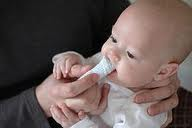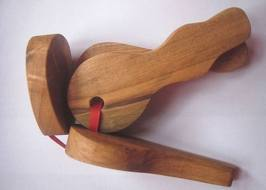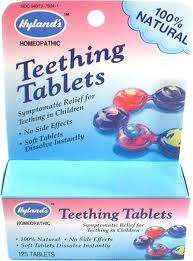
It is extremely difficult to see your child in pain when he or she is teething, but it is an inevitable milestone that each parent has to face. It is part of the growing pains of being a baby, and a parent, and each person will begin the teething process at a different time. Teething symptoms may include irritability, drooling, biting or gnawing, cheek rubbing, diarrhea, fever or insomnia. Fortunately, there are natural steps to help ease your child's pain.
Most children start teething from the fourth or fifth month: about the time they are switching to solid foods. Preemies will start later than other children, but this is an upside: you might get a chance to sleep through the night before the teething begins!
When babies start cutting teeth, the front teeth appear first, and then the molars come along three to six months later. By the time toddler are three years old, he or she may have a full set of baby teeth –20 in all. Teething pain may start a month or two before the first tooth appears, since the gums become swollen and tender as the teeth start to exert upward pressure on them. Molars in particular can cause problems in children who had no problem cutting incisors because the breadth of the back teeth can cause more pressure and pain on the gums.
As parents, our job is twofold: try to keep the little one comfortable by using home remedies and various means of pain relief; and, making sure that the doubled irritability of our toddler does not mask actual illness such as an ear infection. Ear infections occur in children of this age, and the pain may cause crying, refusal of food and other signs similar to those of teething. In fact, many medical personnel tend to put nearly everything down to teething, making it more important than ever that parents be vigilant and assertive in making sure their children's medical needs are being met.
The main difference between teething pain and ear infection pain is that teething pain seems to diminish at times: pain from ear infection worsens. The other very important symptom of an ear infection is fever: fever begins climbs and worsens. Some children may run a low, intermittent fever while teething, but it shouldn’t get worse and should never be high. Doctors are of divided opinion on the issue of teething fever: some say it's totally unrelated to teething and others say it can happen. The fact is that some children do run a low fever when teething and others don't. But if your child has a climbing fever and reaches more than 104 F , seek your pediatrician.

Wet, wring out, and place in the freezer. You may even choose to dip the washcloth in chamomile tea before freezing. A wet washcloth that has been in the freezer for about half an hour may provide some soothing comfort for your teething child, according to the U.S. Department of Health and Human Services. It is an inexpensive and simple remedy that may help alleviate pain. Be sure to store the wash cloth in a plastic zip-lock bag when freezing and to wash it after each use to keep it clean and safe for your baby's mouth. Try different degrees of coldness to see what works best. If the frozen washcloth is too cold, you can also try just dampening it with cold water.

Many teething products to help alleviate pain are available on the market, including teething rings and hard rubber toys. They come in different shapes, textures and usually have a handle for easy grasping. Sometimes parents freeze these toys, but this is not advisable, according to the Children's Hospital Boston. Frozen toys may be too hard and hurt your child's gums. Be sure to not purchase teething toys that contain phthalates. Phthalates are substances that are sometimes added to plastic toys to make them soft, flexible and durable, and long-term use may be harmful to children's health. Try wooden cooking spoons, measuring cups and the famous amber teething necklace.
If your child is having problems getting to sleep because of irritated or swollen gums, a gentle massaging using your clean finger may help. Massaging the gums for two minutes or so may provide some soothing counter pressure. Rubbing an ice cube wrapped in a handkerchief, washcloth or cheesecloth along the gums may also provide some relief. Try home remedies like rubbing the gums with diluted clove oil or vanilla extract. Cloves contain oils that have warming, numbing properties, so that even holding a whole clove against a sore tooth with your tongue can ease the pain long enough to get to your dentist. Clove oil can be rubbed on sore gums to relieve pain, but only use a tiny amount: too much can upset your baby's stomach. Vanilla is a home remedy may work in three ways. First, merely rubbing baby's gums can ease the pain by creating opposite pressure; second, the alcohol in vanilla extract will create a warm sensation that is temporarily comforting. The third way this remedy may work is in the calming properties of vanilla itself. Vanilla is known as a soothing yet energizing agent that reduces anxiety and promotes feelings of well-being. Besides that, vanilla has long been used to cure stomach distress: a baby whose stomach is mildly upset from crying or swallowing large amounts of drool may find vanilla soothing to the tummy as well as the nerves. Many grandparents also swear by rubbing a touch of alcohol onto the gums for the numbing factor, such as Brandy or Bourbon.
Learn the trick of serving frozen treats when toddlers start teething! The cold will feel good on their gums, and it gets them to eat something nutritious. Toddlers love to eat frozen peas, suck on frozen strawberry pops and crunch fruit juice ice spooned from paper cups.
Chilled, slushy food such as applesauce, mashed bananas and pureed peaches may provide some numbing and comfort for teething children, according to The Mayo Clinic. Cold carrots, frozen scallions and frozen celery are also great for babies to chew on during the day. When served cold, these foods may be more appetizing than when eaten at warm or room-temperature. Teething biscuits and crackers are also good for babies. Be sure to only give these types of foods if your child has had them before. Because certain foods may cause an upset stomach or an allergic reaction, introducing new food to a teething child who is already in pain is not the best time to test diet tolerance.
An alternative to the messy mesh feeder (designed to hold frozen fruit for babies to chew on) is a knotted handkerchief or a muslin or cheesecloth sack. Many health food stores sell re-usable tea bags in non-dyed cotton or eco-friendly hemp cloths, which are ideal for the purpose and food safe. Be sure that the tie strings are cut shorter than 9 inches, as longer strings can represent a strangulation hazard for babies.
The Mayo Clinic recommends that you not give your teething child any aspirin-containing products since they may cause Reyes' disease, a condition that affects major bodily organs, especially the brain and liver. Instead of aspirin, consider acetaminophen or ibuprofen to help alleviate pain. Be careful in giving these medications to your children, however, as overdosing may occur. Too much acetaminophen can cause liver damage and overdosing on ibuprofen can cause stomach or intestinal damage. Rubbing any medication (including teething gels) on the gums is not advisable as it may be washed away by saliva. Furthermore, too much medication on the gums may numb your child's throat, which may affect their gag reflex. Be sure to ask your pediatrician about pain-relieving medications for teething before administering them to your child.
Homeopathy is an alternative branch of medicine that relies on tiny amounts of substances to affect a cure by stimulating the body's natural immune response. It is safe and holistic, and the amounts of medicine used are extremely dilute.
Both the Hyland’s and the Boiron (aff) brands are multi-dose homeopathic remedies. The concept here is that though not all babies have the same symptoms, most babies will respond to one of the ingredients included in the multi-dose treatments. You could achieve the same effect by testing various single-dose remedies on your child until you find the one that works best. No baby needs all of the ingredients at once; they’re just included for convenience to cover the most likely candidates for a large number of babies’ symptoms.
Bear in mind that Boiron Camilia is a liquid and a vegan solution, but Hylands is not, due to its inclusion of lactose in the tablet formulation. Also, be aware that parabens are listed among the ingredients of the Hyland’s teething gel, but not the teething tabs. Parabens have been potentially linked (although inconclusively) to cancer, so if you’re the cautious type you might prefer the Hyland’s tablets.
*Please also note that there was a recall in the Hyland’s Teething Tablets in 2010. Please see the end of this article for details regarding the recall.
Other homemade remedies include letting your infant chew on a natural licorice stick (the herb, not candy!) You can find natural licorice in health food stores: real licorice feels cool and also numbs the gums when your baby chews on it.
Wild Fennel is a relative of licorice which grows in areas in Northern California and other parts of the country. The feathery, fern-like leaves and hollow stalks can be chewed or sucked for a cooling, licorice-tasting treat.
Baltic amber necklaces are safe necklaces secured with a traditional screw clasp that not only soothe any baby's teething pains, it boosts the immune system, reduces inflammation, treats discomfort in the ear, stomach and throat, alleviates teething pain, calms and eliminates pain associated with headaches, joint stiffness and colds.
The Baltic amber contains 3-8% of succinic acid, a scientifically examined medical substance used in contemporary medicine. The highest content of the acid is found in the amber cortex--the external layer of the stone. This necklace works by the skin warming the amber which releases healing oils and the oils are then absorbed into the blood stream. The active ingredient is succinic-acid which was analyzed by the pioneer of modern bacteriology, the Nobel-prize winner Robert Koch (1886), who confirmed its positive influence and recent scientific research has also proved that succinic acid has a very positive influence on the human organism. Succinic acid is a powerful antioxidant that helps fight toxic free radicals and disruptions of the cardiac rhythm, succinic acid has been shown to stimulate neural system recovery and bolster the immune system, and helps compensate for energy drain in the body and brain, boosting awareness, concentration and reflexes, and reducing stress.
Los Angeles, October 23, 2010 – Standard Homeopathic Company, in consultation with the U.S. Food and Drug Administration (FDA), is voluntarily recalling its Hyland’s Teething Tablets. The company is initiating this recall in an abundance of caution due to an FDA investigation of its manufacturing facility. Hyland’s Teething Tablets are manufactured in the United States and distributed throughout North America.
1. Hyland’s Teething Tablets, 125 tablets, UPC # 3 54973 75041
2. Hyland’s Teething Tablets, 250 tablets, UPC # 3 54973 75042
3. Hyland’s Teething Tablets, 125 tablets, UPC # 3 54973 75066
4. Hyland’s Teething Tablets, 50 tablets, UPC # 3 54973 75044
5. Hyland’s Teething Tablets, 145 tablets, UPC # 3 54973 75121
6. Hyland’s Teething Tablets, Clip Strip 6x125 tablets, UPC # 3 54973 35109
Adverse events have been reported but the FDA has said that a conclusive link has NOT been determined. The company, in working with the FDA, has identified manufacturing processes of Teething Tablets that can be improved to ensure uniformity in dosage. As a homeopathic product, Hyland’s Teething Tablets have a wide margin of safety that protects consumers from harm.
After in-depth analysis, a comprehensive review of the company’s adverse event report log, and more than 85 years of safe usage, the company is confident that Hyland’s Teething Tablets are safe for infants and toddlers.
In addition to the product recall, Standard Homeopathic Company is refining its production, packaging and testing protocols. Throughout the process, Standard Homeopathic Company will continue to closely monitor and evaluate the situation and consult with FDA.
Consumers that are concerned about the safety of the product may contact Standard Homeopathic Company for instructions on a refund or replacement product. For these instructions or information regarding how to return or dispose of the product, consumers should log on to www.hylandsteething.com/recall or call 1-877-496-5044 (Monday-Friday 9 a.m. to 5 p.m. Eastern Time, and Saturday-Sunday 10 a.m. to 4 p.m. Eastern Time).
“We initiated this voluntary recall to ensure our consumers know that their families’ safety and health are our top priorities,” said Mark Phillips, PharmD, President and Chief Pharmacist of Standard Homeopathic Company. “We are committed to maintaining and deserving the trust they have placed in Hyland’s. We have worked for 107 years to build relationships with our consumers. We intend to preserve that tradition of trust.”
Hyland’s Teething Tablets is a homeopathic product intended to provide temporary relief of teething symptoms in children that is sold over-the-counter (OTC) in retail outlets.
No other Standard Homeopathic Company products are affected by this recall.
Over 100 years of experienced and trusted company, Hylands did have a recall on its teething tablets on October 23, 2010.
